The paper umbrella is a single candlestick pattern which helps traders in setting up directional trades. The interpretation of the paper umbrella changes based on where it appears on the chart.
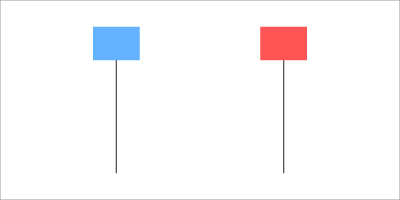
A paper umbrella consists of two trend reversal patterns namely the hanging man and the hammer. The hanging man pattern is bearish and the hammer pattern is relatively bullish. A paper umbrella is characterized by a long lower shadow with a small upper body.
If the paper umbrella appears at the bottom end of a downward rally, it is called the‘Hammer’.
If the paper umbrella appears at the top end of an uptrend rally, it is called the ‘Hanging man’.
To qualify a candle as a paper umbrella, the length of the lower shadow should be at least twice the length of the real body. This is called the ‘shadow to real body ratio’.
Let us look at this example: Open = 100, High = 103, Low = 94, Close = 102 (bullish candle).
Here, the length of the real body is Close – Open i.e 102-100 = 2 and the length of the lower shadow is Open – Low i.e 100 – 94 = 6. As the length of the lower shadow is more than twice of the length of the real body; hence we can conclude that a paper umbrella has formed.
The Hammer formation
The bullish hammer is a significant candlestick pattern that occurs at the bottom of the trend. A hammer consists of a small real body at the upper end of the trading range with a long lower shadow. The longer the lower shadow the more bullish the pattern.
The chart below shows the presence of two hammers formed at the bottom of a down trend.

Notice the blue hammer has a very tiny upper shadow, which is acceptable considering the “Be flexible – quantify and verify” rule.
A hammer can be of any color as it does not really matter as long as it qualifies ‘the shadow to real body’ ratio. However, it is slightly more comforting to see a blue colored real body.
The prior trend for the hammer should be a down trend. The prior trend is highlighted with the curved line. The thought process behind a hammer is as follows:
- The market is in a down trend, where the bears are in absolute control of the markets
- During a downtrend, every day the market would open lower compared to the previous day’s close and again closes lower to form a new low
- On the day the hammer pattern forms, the market as expected trades lower, and makes a new low
- However at the low point, there is some amount of buying interest that emerges, which pushes the prices higher to the extent that the stock closes near the high point of the day
- The price action on the hammer formation day indicates that the bulls attempted to break the prices from falling further, and were reasonably successful
- This action by the bulls has the potential to change the sentiment in the stock, hence one should look at buying opportunities
The trade setup for the hammer is as follows:
- A hammer formation suggests a long trade
- The trader’s entry time depends on the risk appetite of the trader. If the trader is a risk taker, he can buy the stock the same day. Remember, the color of the real body in hammer does not matter; hence there is no violation to the Rule 1. If the trader is risk averse, he can buy the stock the day after the pattern has formed only after ensuring that the day is a blue candle day
- Risk takers can qualify the day as a hammer by checking the following condition at 3:20PM on the hammer day..
- Open and close should be almost the same (within 1-2% range)
- Lower shadow length should be at least twice the length of real body
- If both these conditions are met, then the pattern is a hammer and the risk taker can go long
- The risk averse trader should evaluate the OHLC data on the 2nd If it’s a blue candle, the trade is valid and hence he can go long
- Risk takers can qualify the day as a hammer by checking the following condition at 3:20PM on the hammer day..
- The low of the hammer acts as the stoploss for the trade
The chart below shows the formation of a hammer where both the risk taker and the risk averse would have set up a profitable trade. This is a 15 minutes intraday chart of Cipla Ltd.
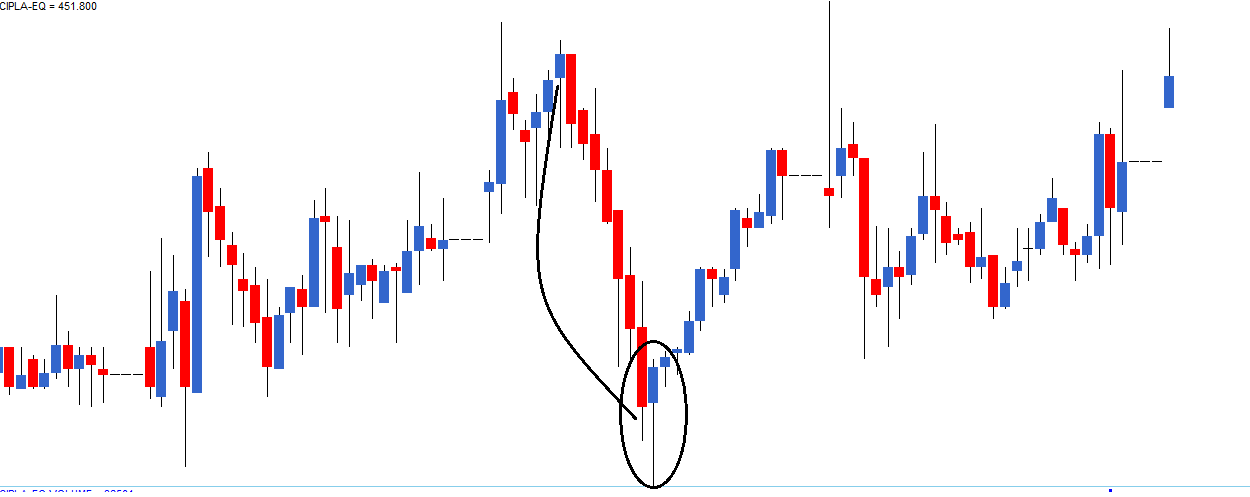
The trade set up would be as follows:
Buy Price for a risk taker – He takes the trade on the Hammer candle itself at – Rs.444/-
Buy price for a risk averse – He takes the trade on the next candle after evaluating that the candle is blue at – Rs. 445.4/-
Stoploss for both the traders is at Rs.441.5/-, which is the low of the hammer formation.
Do notice how the trade has evolved, yielding a desirable intraday profit.
Here is another chart where the risk averse trader would have benefited by virtue of the ‘Buy strength and Sell weakness’ rule.
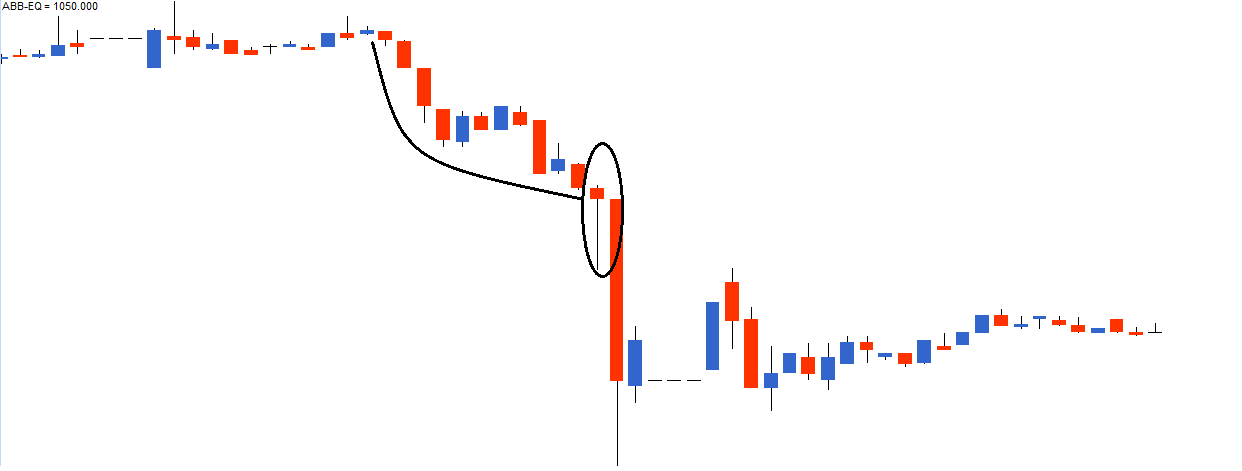
Here is another interesting chart with two hammer formation.
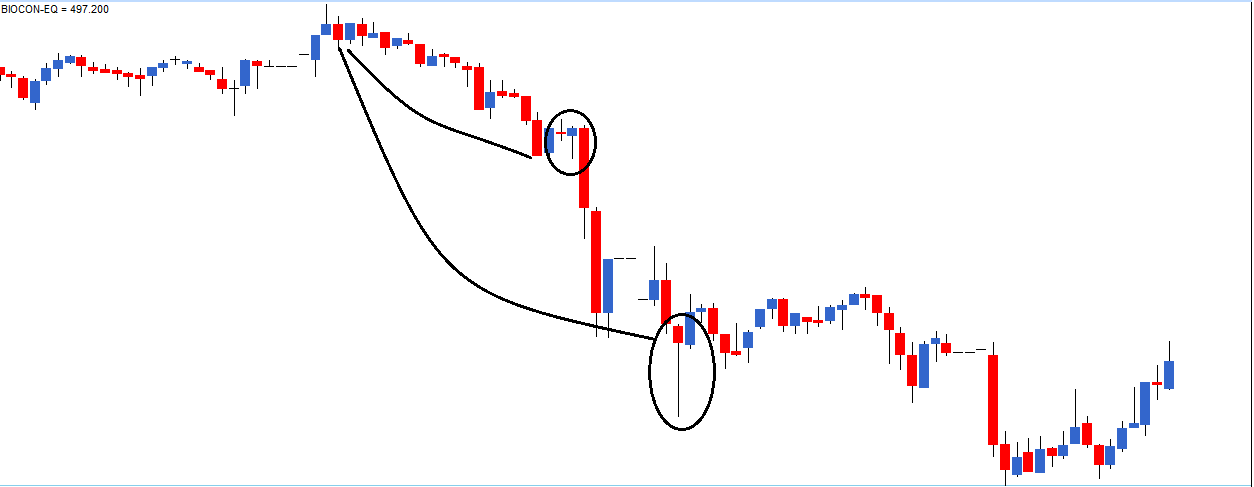
Both the hammers qualified on the pre conditions of a hammer i.e :
- Prior trend to be a down trend
- Shadow to real body ratio
On the first hammer, the risk averse trader would have saved himself from a loss making trade, thanks to Rule 1 of candlesticks. However, the second hammer would have enticed both the risk averse and risk taker to enter a trade. After initiating the trade, the stock did not move up, it stayed nearly flat and cracked down eventually.
Please note once you initiate the trade you stay in it until either the stop loss or the target is reached. You should not tweak the trade until one of these events occurs. The loss in this particular trade (first hammer) is inevitable. But remember this is a calculated risk and not a mere speculative risk.
Here is another chart where a perfect hammer appears, however it does not satisfy the prior trend condition and hence it is not defined pattern.
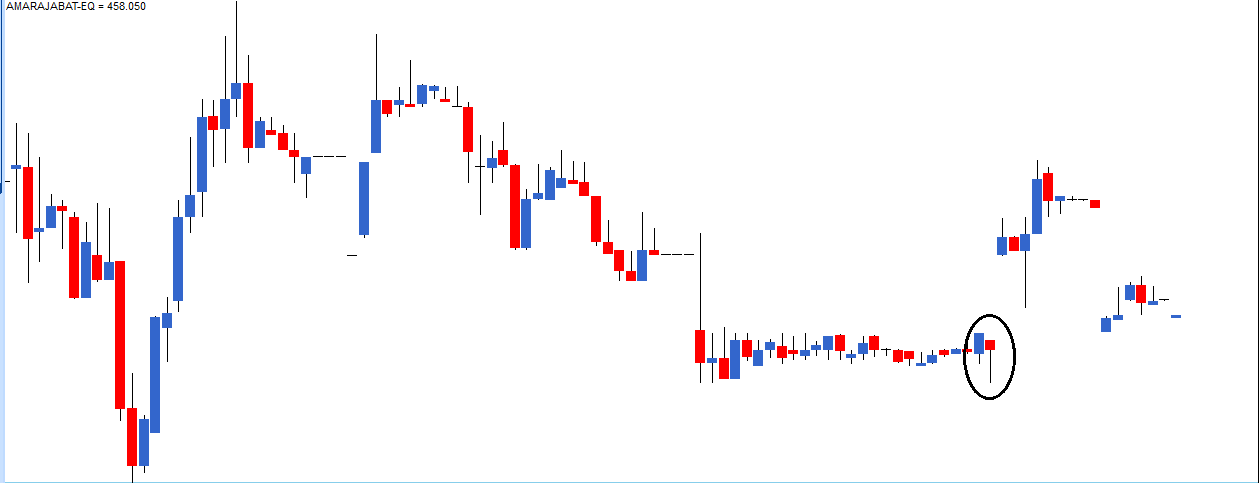



0 Comments